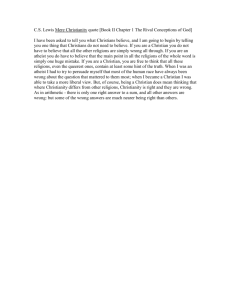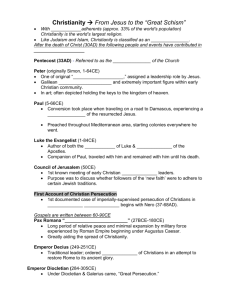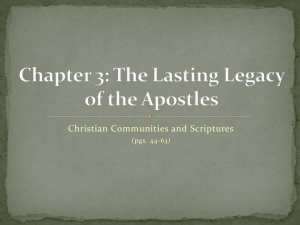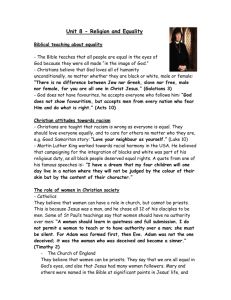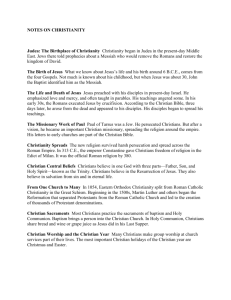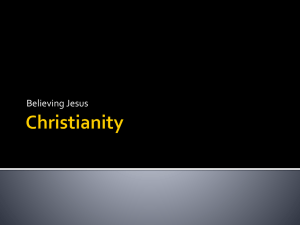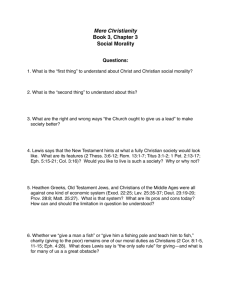World Religions
advertisement
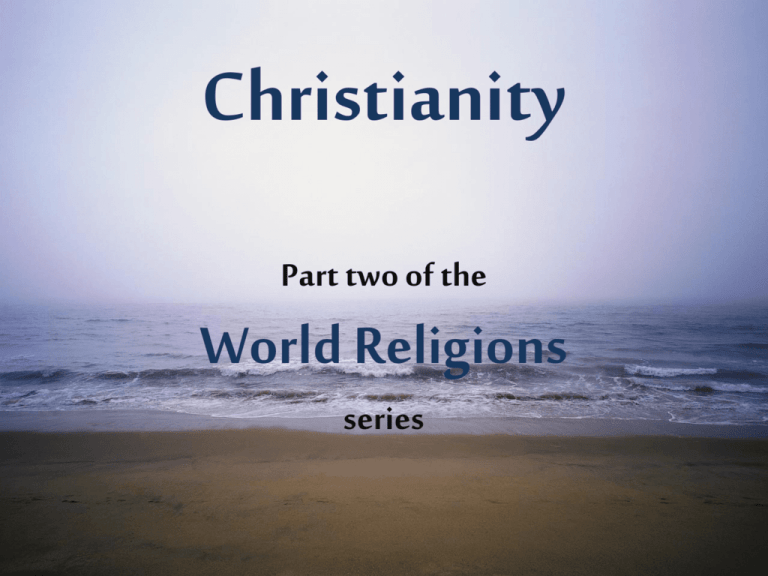
Christianity Part two of the World Religions series Historical Events • Christianity arose from Judaism • Christianity is based on the teachings of Jesus of Nazareth • Early Christians were persecuted for their beliefs, which led many to worship/gather in secret until Constantine I legalized the religion in 313. • Using the formation of the Jewish Diaspora (dispersion), Christians were able to reach Gentile (non-Jewish) communities, thus spreading Jesus’ philosophy • Became the dominant religion over the Roman Empire by the late 4th century Sermon on the Mount Subdivisions (Three largest branches of Christianity) • Catholicism: Distinctive differences include special authority of the Pope, ability of saints to intercede on behalf of believers, the concept of Purgatory (purification of the elect before entering heaven), and that bread used in the Eucharist (Mass) becomes the true body of Christ when blessed by a priest. • Protestantism (Anglicans are within this branch): Emphasizes that Christians can communicate directly with God, instead of through saints and or priests. Praying directly from the heart instead of reciting fixed prayers are encouraged. Their theology demonstrates that there is justification by grace through faith. • Orthodoxy: Scripture is interpreted by the 7 ecumenical councils of the church; emphasis is placed on the practical and personal experience of truth; the Holy Spirit is central to worship (liturgy begins with prayer to the spirit and invocations are addressed to the spirit). Pietà (pity) Beliefs • The Eucharist (Holy Communion or The Lord’s Supper) is the central symbol of the death of Jesus on the cross and established the new covenant (formal alliance/agreement). • Jesus’ resurrection is central to Christian belief. • Jesus is the son of God and represents the person that all Christians strive to be like. • God, is the all-powerful creator and everything he created is an expression of his power and love. • The Holy Trinity means that God is the Father, the Son, and the Holy Spirit. • Christians follow ten commandments. The Ten Commandments (summarized from the Bible): 1. You shall have no other Gods before me. 2. You shall not make for yourself any carved image. 3. You shall not take the name of the Lord your God in vain. 4. Remember the Sabbath day, to keep it holy. 5. Honor your father and your mother. 6. You shall not murder. 7. You shall not commit adultery. 8. You shall not steal. 9. You shall not bear false witness against your neighbor. 10. You shall not covet your neighbor’s house, wife, etc. Resurrection Customs and Rituals: • Prayer is a large part of a Christian’s life and can be personal (as a private act) and communal (in Church). Prayers are used to thank God for his gifts, for forgiveness, and for blessings and favors. • Baptism is an important ritual because it marks the beginning of a person’s life as a Christian and symbolizes the washing away of all past sins. Baptism of Jesus Facts: • The term Christ originated from the Greek word Xristos, meaning “the anointed one” and is a title applied to Jesus to indicate status. • The term catholic means universal. • “Born again” refers to the belief that God forgives the sins of all who repent and wish to lead a new life. • The title Pope originated from papa in Latin and pappas in Greek, which means father. Sacred Texts • The Holy Bible is the text that Christians use. It is divided into two books; the Old and New Testaments. The Old Testament consists of Abraham’s relationship with God and the people of Israel. The New Testament refers to early Christians and their new covenant with God through Christ. •Church services often include a reading (lesson) from the Bible. •Catholic and Orthodox Bibles sometimes include the Apocrypha (hidden books), which were written between the Old and New Testaments. Symbolism • The fish symbol is a well known icon among Christians and non-Christians alike. Some scholars believe that it was a symbol used to recognize other believers when early Christians were persecuted for their faith. When meeting a stranger they identified themselves by drawing an arc in the sand. If the other person was a Christian, they would draw a second arc, completing the fish. If the person was not a Christian, then the one arc would not reveal who they were. •Alpha and Omega are other symbols used by Christians. They are the first and last letters of the Greek alphabet, which together signifies that God is the beginning and the end. Current Events • Church Works with U.S. to Spare Detention • Is this Christianity's FIRST church? * Links available in ppt version “Even the least among you can do all that I have done, and greater things.” Jesus of Nazareth Resources Available in Holly Library • The unauthorized version : truth and fiction in the Bible by Robin Lane Fox • The Oxford illustrated history of Christianity, edited by John McManners • Science and creationism, edited by Ashley Montagu • The Western tradition, video, WGBH, Boston ; in association with the Metropolitan Museum of Art ; executive producer, Fred Barzyk • World Christian encyclopedia : a comparative study of churches and religions in the modern world, AD 1900-2000, edited by David B. Barrett • The HarperCollins encyclopedia of Catholicism , general editor, Richard P. McBrien • The Gospel of Judas, DVD, produced by National Geographic Television & Film ; produced & directed by James Barrat ; written by John Bredar, James Barrat Bibliography • Couliano, I; Eliade, C.; Wiesner, H. (1991). The Harpercollins Concise Guide to World Religion. Harpercollins Publications • Pollock, Robert (2002). The Everything World’s Religions Book: Discover the Beliefs, Traditions, and Cultures of Ancient and Modern Religions. F + W Publications, Inc. • Parrinder, Geoffery, Editor, (1971). World Religions: From Ancient History to the Present. The Hamlyn Publishing Group Limited, Newnes Books, 1983. • Religionfacts website (www.religionfacts.com) Image Resources • • • • • • • • Slide 3: http://powerspectaclememory.files.wordpress.com/2008/10/sermon-onthe-mount.jpg Slide 5: http://crazymindseye.files.wordpress.com/2008/05/pieta4.jpg Slide 7: http://freechristimages.org/images_Exodus/Moses_with_Ten_Commandments_ Champaigne_1648.jpg Slide 9: http://www.whiteheadcarvings.com/images/gallery/Resurrection_of_Jesus.jpg Slide 11: http://www.christusrex.org/www1/stanzas/L51b-Baptism.jpg Slide 13: http://samuelatgilgal.files.wordpress.com/2009/09/holy-bible.jpg Slide 15: http://z.about.com/d/christianity/1/0/f/2/Christian_Fish.png , http://alpha-yomega.com/&usg=__iLY6Za5eED87vOzcYzD59iZO2jE=&h=400&w=400&sz=12 &hl=en&start=7&um=1&tbnid=UWdjkEIYLJRdeM:&tbnh=124&tbnw=124&prev=/i mages%3Fq%3Dalpha%2Band%2Bomega%26hl%3Den%26rls%3Dcom.micros oft:en-us%26sa%3DN%26um%3D1 Slide 17: http://jahdai.files.wordpress.com/2009/04/church.jpg , http://www.saintpetercatholic.com/images/main-church.jpg , http://www.nytimes.com/imagepages/2009/12/13/nyregion/13indonesians_CA0.h tml , "First Church" article Next in the World Religions series: Hinduism
